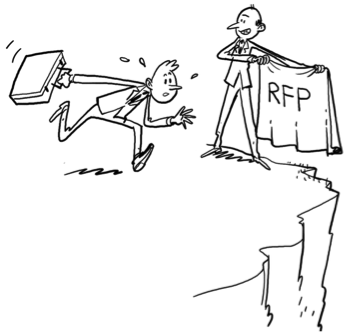 “It’s slow and it doesn’t function properly. We are going to have to redesign the way the government purchases digital – from soup to nuts. It’s simply not working”. These words are from a recent TV interview with the President of the United States.
“It’s slow and it doesn’t function properly. We are going to have to redesign the way the government purchases digital – from soup to nuts. It’s simply not working”. These words are from a recent TV interview with the President of the United States.
President Obama goes on to describe how he designs and purchases the IT for his election campaigns, which remember have been hugely successful twice over. “We’ve got 4 guys in T-shirts in a room and we figure out how to do this right?” Almost the complete opposite of a conventional purchasing process based on a huge requirements gathering exercise followed by a long winded tendering process. He may have been talking about IT but the same criticisms apply to a range of complex B2B purchases – they are slow, they don’t function properly and most important of all they don’t guarantee to deliver the best solution for the buyer.
Maybe this is the beginning of the end of the RFP as we know it?
Can Sales change the way purchasing works?
At this point you might be forgiven for saying something like ‘Yes Phil, we know RFP processes don’t work but we have to jump through the hoops to win the business’. And to some extent you are right, this blog should be read by purchasers (maybe you could send links to a few) as well as Sales Professionals. But you can help to improve the process and I have seen it done. But first lets take a closer look at the problem.
Why the RFP process doesn’t work
I have talked about this particular example before but let me briefly remind you of a RFP situation that cost us a great deal of time and money when there was no real chance of success.
My Infoteam colleague is very enthusiastic and committed to generating new business. This was potentially a very big deal for him, to implement a Sales Transformation across a large state-owned defence supplier with 10 divisions. And very importantly, he thought he had a Coach within the customer organisation.
When asked directly if our proposal would be given full and fair consideration his Coach assured him it would. The instructions from procurement were that at least 9 competitive offers had to be submitted. That’s why our Coach did everything he could to keep us in the running.
With the encouragement of the “Coach” we went ahead. The RFP was 120 pages long and it took 3 of us 3 weekends to complete – about 150 hours work. We submitted it and waited. And waited. Eventually we heard we had not been successful so my colleague contacted his Coach for feedback and discovered some very interesting things.
The work had gone to a rival who, it turned out, was already working with one of the companies in the group. When the HR team who were running the process looked through the proposals they felt they were not qualified to judge the solutions so they passed them on to a group of managers. The same managers who were already working with the company who won.
How this illustrates the flaws in the RFP process
Let’s run through what is wrong with RFPs and the consequences for Buyers and Sales People.
-
It takes too long. Modern businesses need to be responsive. Most B2B companies are part of a supply chain and nobody can wait while each part of the chain goes through a lengthy procurement process. Incumbent suppliers are chosen because it’s the only way to get things done quickly.
-
It costs too much. There is an army of Sales Professionals and Procurement Professionals out there and by definition – if 5 vendors submit proposals and only one wins 80% of the time has been wasted. Many subject matter experts have been diverted from revenue generating activity and that also costs money. The customer may not pay directly for the wasted time but they pay indirectly because all vendors have to maintain the overhead of pitch teams.
-
RFPs stifle innovation. This has several causes. The first is that the time and money involved in RFPs means customers just go with the existing vendor because it is quicker and cheaper in the short term. Then there is the problem of flawed and bloated requirements gathering. Buyers consciously or unconsciously tend to draw up a spec that matches an existing solution or they cover every possible base that means the solution is more expensive than it needs to be. And new suppliers with exciting new ideas sometimes cannot afford to respond to big RFPs so the large companies that really need innovation unknowingly exclude the potential suppliers who can provide it.
-
The RFP process excludes strong alternative suppliers. In the example I described above we should have qualified the lead better and not wasted our time responding to the RFP. But the procurement process required a certain number of potential suppliers. When we looked carefully the vendors who responded included - the eventual winner, ourselves and a raft of organisations that were not really up to the job. All the other serious contenders saw the incumbent had an advantage and declined to respond, so the buyer didn’t see many real alternatives.
What can vendors do?
To be honest we can’t change a broken system by ourselves. We need to work with procurement people and business leaders to find a better system. I am glad to say I was recently involved in a large RFP process that was run in an innovative way that made the RFP process much more effective.
A new way to run an RFP
I worked as a consultant in this process and it was very interesting and extremely effective in creating a leaner, better process that delivered an excellent solution – a new Marketing & Sales Academy for a global chemicals company.
The first step was for this large multinational to get a budget to pay potential suppliers to participate in the process, a move which is almost unprecedented in my experience.
The initial stage was familiar; the company put together it’s requirements while they drew up a shortlist of potential suppliers. Then it changed. They selected 4 vendors from the shortlist and paid them to take part in a series of workshops where they were asked to critique the requirements put together by the company. The process was very interesting and the results extremely valuable.
Many changes were made to the requirements. For instance, the original requirements were all about training new hires and sales people but they were changed to include senior management because the vendors knew that was essential to make training stick.
As a bonus, the vendors got to meet key people in the Buying Centre and the buyers got a feel for how it would be to work with the vendors. The vendors still had to go away and write a proposal but it was one more likely to deliver the right solution and fewer vendors wasted time on proposals that had no chance of winning.
What should you do now to deal with RFP situations?
We can’t fix this overnight and not every vendor or purchaser wants to. The largest vendors see that unwieldy RFP processes crush smaller challengers. Procurement people may think that a leaner system will mean fewer jobs. But most people want a system that gives buyers the best solution quicker and costs less.
This is what you can do now.
-
Qualify. Qualify every lead and don’t waste your time on RFPs that you are unlikely to win.
-
Challenge. If you see an RFP that clearly won’t deliver the best solution challenge it. Suggest a better option. You may find procurement people are so desperate to keep enough vendors in the process that they will be receptive.
-
Suggest alternatives. If you can talk to the buyer you can suggest things like a requirements clarification workshop or even a small project as a way to let the buyer experience the potential of the solutions and the quality of the teams delivering it rather than just reading through documents.
-
Create case studies. Work with existing customers to calculate the real cost of an RFP process including all the overheads and opportunity costs and compare it with a lean procurement process. Then use those case studies to help convince new prospects.
We may not be able to change the RFP process overnight but customers who can procure better solutions more quickly and cheaply will have a competitive advantage. And that is what everyone is looking for.
Ask yourself this
-
Do you qualify leads rigorously – especially RFPs?
-
Do you challenge RFPs that you know will deliver a poor solution?
-
Do you help your customers to build leaner procurement processes?
Enjoyed this blogpost? Download our eBook:

